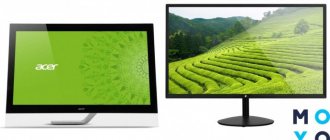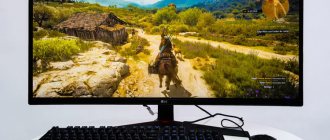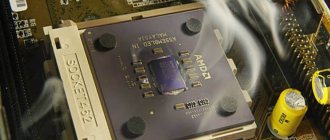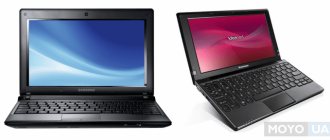(opens in a new window) While tablet supply remains limited, the laptop situation looks chaotic. Buyers can choose from hundreds of models in various sizes, which also come in countless configurations. Our guide will navigate this jungle of models and explain what components you should pay attention to in laptop specifications.
For a better overview, we have highlighted the main characteristics of laptops and divided the devices into three categories: for office tasks/web surfing ( up to 40,000 rubles ), universal ( up to 80,000 rubles) and high-performance ( over . We'll also show you what special concepts like the Convertible or Chromebook can do.
How important is clock speed?
At first glance, it is difficult to understand what the difference is between the processors in different laptops and even in the configuration of the same model. The fact is that at a time when processors were simple (single-core), and the number of models used by manufacturers was relatively small, everything was relatively simple: the newer the chip and the higher its clock speed, the better.
Clock frequency is the number of operations that a computer performs in one second; this frequency is measured in MHz (megahertz). To find out more about what this is, follow the link above.
Now everything is not entirely true, especially if we talk about chips intended for laptops - a high clock frequency does not always mean that you bought a high-performance processor model .
In this article we will look at how to determine which processor is right for you.
In general, when choosing a processor you need to focus on:
- processor manufacturer;
- the presence of “built-in” or “dedicated graphics / combining both;
- energy saving;
- clock speed and cache size.
Processor architecture refers to how its main elements are located inside the processor. Certain processor capabilities depend on this. This is a complex device consisting of a huge number of transistor cells. Therefore, a new architecture is always a step forward, an increase in performance, new, more stringent technological standards, and so on. The more modern the architecture of the processor installed in your laptop, the better.
Phenom processor architecture.
Gaming laptop vs gaming PC - what to choose?
Gaming laptops have become a part of our lives - they are sold in all electronics stores, they are produced by many famous manufacturers, and the number of models exceeds several hundred.
And, of course, wherever there is a choice - and in our case it is a choice between a laptop and a PC - holivars begin on the topic “which is better?” In this article, I propose to understand some of the myths about gaming laptops that came straight from the beginning of the 2000s, and some of the features of modern gaming PCs that tip the scale in favor of laptops.
For the price of a gaming laptop, you can build a PC with the same performance, and you’ll still have money left over for an ultrabook, since mobility is so important.
Well, five years ago this was indeed the case - mobile processors were noticeably weaker than desktop ones, and mobile video cards were separated into a separate line, the representatives of which were again seriously weaker than their desktop counterparts. But now this is not the case: mobile 6-core processors are not much weaker than their desktop counterparts, and there is no such thing as a “mobile video card” at all - laptops use the same GPUs or even better (if we are talking about the GTX 1070).
But let's return to the question of price - is there such a big difference between a modern laptop with a 6-core i7-8750H and GTX 1070 and a PC with the same performance? Prices for laptops with such hardware start from 107,000 rubles - for the version with 16 GB of RAM, a 1 TB hard drive and without a system:
Let's try to assemble a similar system on one of the largest electronics sales sites in Russia - Citilink.
The choice of processor is simple - the i7-8700 is quite close to the 8750H, but for cooling you can use the time-tested “tower” from DEEPCOOL. We will take the motherboard from ASUS, as well as the laptop, and taking into account the fact that the latter runs on the HM370 chipset, the choice of chipset for the PC is obvious, H370. Alas, I couldn’t find any boards with built-in Wi-Fi on sale, so we’ll buy a separate expansion board with 5 GHz support.
RAM is the simplest set of 2 8 GB DDR4-2400 dies. The drive is also a completely ordinary Seagate 1 TB. The video card - of course, GTX 1070, the cheapest option in Citylink was from Palit - is not the worst solution, so we’ll take it. Power supply - KSAS 500 W (yes, I know that many people don’t like this line, but for the money it’s good). Case - you could take a simple “tin” for 1000 rubles, but still the laptop is metal and gaming, so let’s also take a “gaming” case - Zalman N2.
Also, do not forget that a laptop is also a monitor with a keyboard, so our PC needs both. The simplest 1080p IPS monitor with HDMI was from LG, but for a “gaming” keyboard you can take the A4 Bloody. I don’t count the mouse, because for playing games from a laptop you will also have to buy one. There is no system on a laptop, so we won’t count it for a PC either.
How much does the final assembly cost? 94,000 rubles:
That is, when buying a PC with the same performance, you will be able to save about 13,000 rubles - alas, it is impossible to buy an ultrabook for that kind of money (well, only if you are a masochist and want to use it). Therefore, the myth that gaming laptops are almost twice as expensive as PCs with the same performance remains a myth.
Gaming laptops overheat and make a lot of noise.
Yes, indeed, 10 years ago they did not yet know how to make efficient fans and heat pipes, so temperatures of 90+ degrees were the norm. But for the last few years this has not been the case - for example, in the MSI GE73 8RF Raider laptop similar to the ASUS above, the GPU temperature after an hour of playing Witcher 3 was only 77-78 degrees (screenshot from the Notebookcheck website):
Even by PC standards, this is very little - for example, reference video cards often heat up to 80-85 degrees, so overheating of gaming laptops is a myth.
As for the noise of gaming laptops, it reaches 50 dB - can be compared with the background noise of an office space. In general, modern system units “sound” quieter, so if you like to play without headphones, these are your choice.
Gaming laptops instantly become clogged with dust, and then there is the point above.
Absolutely any equipment becomes clogged with dust; it all depends on the distance between the radiator fins and the general dustiness of the room. In general, the situation here is the same - you need to do preventive cleaning of both your PC and laptop at least once a year. True, some laptops have reverse fans - they begin to rotate in the opposite direction, which allows you to clean the radiator from dust. But if we take the “average temperature in the hospital”, both types of equipment are dust collectors.
Gaming laptops are “coffins” weighing under 5 kg and battery life per hour.
Yes, there are laptops even heavier than 5 kg and with a diagonal of up to 21″, but technology has reached the point where the GTX 1080, albeit with reduced frequencies, can be installed in an ultrabook weighing 1.8 kg and less than 20 mm thick - for example, these are exactly dimensions and weight of ASUS Zephyrus:
The same applies to battery life - of course, in laptops where integrated graphics are disabled, you can’t count on long-term work away from a power outlet, but taking into account the fact that in most laptops, under light loads, energy-efficient integrated graphics work, and processors can very greatly reduce the frequency, then 4-5 hours of surfing the Internet ceases to be something unrealistic for gaming machines: for example, an ASUS Zenbook with a powerful 6-core Core i9 and a 4K screen allows you to surf the Internet for about 6 hours:
As a result, if you wish, you can find a lightweight and stand-alone gaming laptop.
Also, do not forget that the battery is an excellent source of uninterruptible power: if the power suddenly goes out, you can always save your game progress or continue playing further (though not for long). Upgrading a gaming laptop is fantastic.
Yes and no. Most laptops (not necessarily gaming ones) allow you to replace the RAM and storage. But few people know that video cards are not always soldered - the MXM standard has long existed, which is a small board with a video card that, if desired, can be removed and replaced with a more powerful one. Considering that modern mobile 6-core processors will last at least 3-4 years, replacing the MXM video card with a newer one is quite a solution.
But in general, yes, PCs can be upgraded easier and cheaper, and there are more opportunities in this regard. Although Intel's policy of recent years (new processor = new chipset = new motherboard) is very frustrating in this regard, because often when upgrading you have to change everything except the case and the power supply with drives.
Why buy new, if you can buy used components, or even order an Intel Xeon from China for 1000 rubles and a Huanan motherboard - this is not the case with laptops.
The used market is a separate topic, which I will not touch on for one simple reason: in order to buy really working components there that will not stop working after a week, you need to understand it very well. We are talking about something that even a non-technical person can do - go and buy a laptop in a store, or order a PC assembly there.
The same applies to Xeon from China: yes, of course, this is an extremely profitable purchase - if you can find a working board for it, which again pushes us into the used market. Well, to follow up, no one has canceled Chinese gaming laptops, for example, from the company Thunderobot: they cost significantly less than similar branded solutions, but again require “finishing with a file.”
A gaming PC is a huge box weighing ten kilograms, not like a compact laptop, which does not need a separate place.
A fairly popular argument among fans of mobile gaming is that you can easily take a laptop with you and play, for example, in the countryside. Moving the system unit is problematic. And this was indeed the case until recently, but now there are ultra-compact cases that allow you to assemble an extremely powerful gaming machine in them (even with an i7-8700K and GTX 1080 Ti), and the weight of the finished solution will be less than 5 kg:
Also, do not forget about the new Intel NUCs, which, with a volume of one liter, have a graphics card of the GTX 1050 and even 1050 Ti level and full-fledged 4-core i5 and i7. But, overall, if you don't just play games at home, then a laptop will be the best choice.
A gaming PC is always a bunch of wires, not like a laptop.
Don't forget about Bluetooth, with which you can connect a mouse, keyboard, and headphones. The only thing that requires a physical connection is the monitor - but it’s hard to call one wire a bunch.
Repairing a laptop is a real possibility of being left without it for a month. PC repair is simply the repair of a separate part, and often, even if not fully, you will still be able to use the computer.
This is exactly the case - of course, if the RAM or storage device fails, then the laptop has no problems replacing them. But if the problem is with something else, then often the entire motherboard is replaced under warranty, and until it is delivered to your service center, you will be without a laptop. In the case of a PC, there are no such problems: the video card has stopped working - you can temporarily sit out on the integrated one (or buy a plug for 1500-2000 rubles), the motherboard has stopped working - again, you can temporarily find a solution on the cheapest chipset.
You need to know how to assemble a computer, but you just take the laptop out of the box and you can use it right away.
Fortunately, this is no longer the case - large stores offer PC assembly if you purchase all the components from them, often for free. So at the end of the day you still get a ready-to-use computer.
To properly configure a PC, you need to understand the hardware. In laptops, everything is immediately well selected.
Alas, there are a lot of unbalanced laptops: for example, solutions based on AMD A10 or Core i3 processors along with video cards of the GTX 950M or MX150 level are quite popular, and there are also enough laptops with a GTX 1070 and 4-core 4-thread Core i5-7300HQ. Moreover, such solutions are often significantly cheaper than balanced ones, and ignorant people who choose a laptop purely based on the video card have a chance to buy them and then wonder why such a powerful video card plays games so poorly.
So, when choosing any equipment, you need some knowledge of the “material parts”, but still in the case of laptops you need to know less: for example, the power supplies are always normal, you don’t need to choose a motherboard and cooling system.
What's the end result? But in the end, we get an interesting situation - over the past 10 years, the situation on the computer market has changed a lot: equipment is becoming more mobile, cooling systems are more efficient, processors are more economical, batteries are larger - and therefore gaming laptops are no longer what they used to be. Well, what to take is up to you and only you.
The importance of RAM and cache memory when choosing a processor for a laptop
Another fundamentally important parameter for assessing performance is the amount of cache memory built into the processor. The fact is that the exchange of information between processor cores and cache memory is much faster than with RAM (random access memory). As a result, the larger the cache size, the faster your processor ends up being. Moreover, in real tasks, a large cache size is needed more often than additional cores or too high a frequency. However, the larger the cache memory, the more expensive the processor is . In addition, increasing memory leads to heating of the processor.
If we talk about a specific purchase, then when choosing a processor of the same series and line for multimedia systems and workstations, preference should be given to those with a larger cache memory.
The best processors in terms of price and quality ratio
The best chipsets for those who want to get maximum capabilities at an affordable price.
AMD Ryzen 5 2500U Processor
This processor went on sale at the end of 2020 and, despite its age, today combines an excellent price tag and decent characteristics. It was created using a 14 Nm technical process, which is due to the year of manufacture and this is perhaps the only drawback. It received four cores with two threads, a base frequency of 2 GHz with an increase, if necessary, to 3.6 GHz. This means that under light loads it will not waste a lot of energy, but at the same time it will not give up in games or resource-intensive applications. Heat dissipation varies from 12 to 25 W. The chipset supports Free Sync technology, SenseMI and is equipped with integrated Vega 8 graphics.
Advantages:
- low heat generation;
- intelligent overclocking;
- high maximum clock frequency;
- energy efficiency;
Flaws:
- supports RAM with a frequency of no more than 2400 Hz, but if you do not consider it as a gaming solution, then this does not play any role.
Customer Reviews
Sergey S
Runs many games at low or medium settings, 4/8 cores/threads, runs 4K video on YouTube.
Rais Kamaletdinov
Yes, its performance is not gaming-grade, but for myself I installed StarCraft II and The Witcher 3, for Wife WOW and Diablo 3. These are not new games, so it’s a blast.
AMD Ryzen 3 3300U Processor
AMD Ryzen 3 3300U is a lower class than the previous AMD Ryzen 5, but it appeared on the market later, which makes it a little more expensive. It is made using a 12 Nm process technology, has 4 cores with a base frequency of 2.1 GHz, but the overclocking here reaches 3.5 GHz. The nominal heat dissipation is 12 W, but under load it can reach 35 W. In addition to slightly lower performance characteristics, this model received weaker integrated graphics - Vega 6 with six cores instead of 8, like the Vega 8 in the previous processor.
Advantages:
- can be used in thin devices;
- good performance for multitasking.
Flaws:
- discrete graphics are required for games;
- not the best autonomy.
Customer Reviews
Olga K.
My husband gave it to me on March 8th, I am very pleased. Works fast. I mainly do office tasks, Google Docs, and occasionally Photoshop or video compilers of all sorts, so overall it copes without problems. Never froze yet. But with autonomous operation I expected better. 3-3.5 hours and discharges, if intensely.
Raul Rodrigues
It’s just an ideal machine for work and entertainment, the processor is powerful, the built-in video carries everything you feed it (I haven’t tried heavy toys, but it pulls trains with a bang), the system is VERY responsive, unlike Intel’s (I compare it with a Dell office one).
Processor Intel Core i5-6200U
Processors from the Core i5 family are the best choice for those users who plan to work and sometimes play. This modification is quite old and is energy efficient, as indicated by the letter “U” in the name. Today, laptops based on this chip are relatively affordable, but they perfectly solve work tasks and allow you to play. The processor is manufactured using a 14 Nm process technology, has two cores with two threads and a clock frequency of 2.3 GHz. when overclocked it reaches 2.8 GHz. The heat dissipation of the chipset is 15 W, which allows it to be used in thin laptops without fans, but without compromising performance. Integrated graphics – Intel Graphics HD 520.
Advantages:
- low heat generation;
- high autonomy;
- high base frequency.
Flaws:
- weak integrated graphics;
- low maximum clock frequency.
Customer Reviews
Tatiana S.
Plays games great. The charge holds well all day long with continuous use.
Hatsune Yoru
Suitable for old games, but new ones are also suitable (not all). Is it possible to buy it? Yes, quite normal for the Internet, online video, desktop software and even some new games.
Energy saving
Power consumption depending on the processor. Below are the most greedy processors.
Most laptop processors are designed to be as low power as possible. All modern AMD and Intel chips support a feature such as Enhanced Intel Speedstep Technology or AMD Cool'n'Quiet (depending on the manufacturer). When your laptop is not too busy with complex calculations, this feature reduces the processor clock speed and voltage. As a result, it is possible to gain more battery life while reducing energy consumption and heat generation.
In addition, so that a modern fast chip can be placed in a thin ultrabook case, processor manufacturers began to release their energy-saving models, allowing you to build a quiet, cool system with decent battery life.
It is clear that the less heat generated, the better, but mainly energy is saved by reducing productivity . And if it does not decrease, then the price increases significantly.
As a result, it turned out that while an energy-saving processor is exactly what you need for office and mobile use, it is not very suitable for games or video processing.
Models up to 80,000 rubles
In terms of performance, mid-range devices are suitable for resource-intensive programs. By default, they are equipped with an SSD drive and provide a battery life of more than nine hours. In this price category there are the most balanced models in terms of price. Greater functionality compared to the budget segment and no overpayment, as in premium laptops.
One of the “delicious” laptops under 80,000 rubles is the DELL G5 3590. Here you will find everything you need for a comfortable life. 16 GB of RAM will allow you not to limit yourself in heavy professional applications and games. Even the insatiable Chrome will be satisfied. The i7-9750H processor paired with the relatively new GTX 1660 Ti with 6 GB of video memory will allow you to run 90% of modern games. Another tandem, consisting of an SSD + HDD with a total capacity of 1256 GB, will provide fast operation in the system and space for multimedia files. A significant disadvantage that arises from a weak battery and high performance is the battery life of 4 hours. If you want more, then be prepared to sacrifice the capabilities of the graphics accelerator with your current budget, for example, as in the Acer Nitro 5 (AN515-52-79JU).
Intel Haswell - a series of the most popular mobile processors
Currently, the leading mobile processor line is the fourth generation Intel Core series of chips – Haswell.
As in previous generations, the Haswell series produces three processor lines:
- Intel Core i3;
- Intel Core i5;
- Intel Core i7.
At the same time, the Core i7 line includes both dual- and quad-core models.
The series includes mobile and ultramobile processors that were also produced in previous generations. In addition, the Haswell line was the first to make ultra-ultramobile chips. You can determine which specific processor the manufacturer installed in your laptop by the letter index located after the four-digit numeric index of the chip.
Intel has adopted the following designations (suffix for this line):
- Y - processor with extremely low power consumption; 11.5 W
- U - ultramobile processor with low energy consumption; 15-28 W
- M - mobile processor; 37—57 W
- Q - quad-core processor;
- X - extreme processor; top solution
- H - processor made specifically for high-performance graphics
The Extreme Processor does not pose a danger to users, despite its name. This line provides processors with maximum performance.
In general, if you decide to choose a specific type of processor for a laptop, then for productive systems we can recommend i5 and i7 “4ХХХ M” chips . As an option - i7 “4ХХХ U”, and for those who are more interested in the autonomy of the laptop, you should consider the option with “4ХХХ Y” chips. But you must be prepared for the fact that the performance of such systems leaves much to be desired.
Other technical specifications
So desktops have a place in the GPU department, but what about other components?
- CPU. Like GPUs, both Intel and AMD have mobile versions of their processors with reduced heat and power consumption. But again, they are always weaker than their desktop counterparts.
- RAM – Laptops usually have less RAM, and some allow you to install additional RAM modules, although this is rarely needed.
- Memory. Laptops have limited space, so installing additional hard drives or SSDs is not necessary. However, there are options to either replace your existing HDD/SSD or use external storage.
As you can see, gaming laptops do not lag behind in terms of system characteristics. However, their expandability is more limited than that of a desktop computer.
Which laptop processor to choose: configuration options
Laptop for work and study
Let's start with undemanding tasks: such as working with documents in office programs, email, as well as surfing the Web through a browser and watching videos on Youtube and other services. For all this, a laptop with a Celeron, Pentium and Core i3 processor (in ascending order of needs) will be enough for you. When purchasing, you should pay attention to the processor version, so that the year of manufacture is newer and the system disk capacity is from 128 GB. As an optimal option, we offer three laptops with different processors for office performance, but with good equipment:
A laptop for everyday tasks and hobbies
If you have more serious plans for the performance of a workhorse, you should look towards models costing more than 45,000 rubles and equipped with Core i5 or Core i7 processors. Such a laptop will allow you to not be too nervous when a Windows update suddenly starts automatically or when more than 3 tabs are opened in the browser. Of course, a lot depends on the modification of the laptop, but the best option is to choose models with at least 6 GB of RAM and an SSD as the system drive. All this can be purchased and installed later. So, we offer three laptop models with different processors, but with good equipment.
A powerful laptop for work and play
As we have already said, a power reserve never hurts, as long as the allocated funds allow. Let’s assume that you are ready to pay from 70,000 rubles to 90,000 rubles for the car you need). In such a laptop, it is desirable to have a powerful Core i7 processor, a modern GeForce 1050 or 1060 video card and a sufficient amount of RAM (from 8 GB) and a high-speed SSD drive, as well as a HDD. Here are three interesting proposals:











